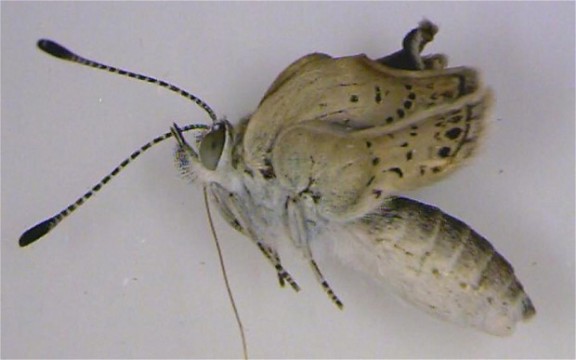 Fukushima nuclear plant disaster caused mutant butterflies, scientists say. Exposure to radioactive material released into the environment has caused mutations in butterflies found in Japan.
Fukushima nuclear plant disaster caused mutant butterflies, scientists say. Exposure to radioactive material released into the environment has caused mutations in butterflies found in Japan.
The new discovered species of butterflies have bizarre dents in their eyes, their legs are shrunken and they are marked by strange spots. Many of those butterflies are infertile and when they do conceive the offspring are even more mutated than the parents.
The study found that mutation rates were much higher among butterfly collected near Fukushima after the memorable nuclear explosion. The scientists write that the Zizeeria maha population in the Fukushima area is deteriorating physiologically and genetically.
Most likely, this deterioration is due to artificial radionuclides from the Fukushima Dai-ichi NPP, as suggested by their field work and laboratory experiments in Japan.
Fukushima disaster caused butterflies mutations / Fukushima butterflies carry mutations for three generations
Genetic butterflies mutations have been found in 3 generations of butterflies from near Japan’s crippled Fukushima nuclear plant, raising fears radiation could affect other species.
By comparing mutations found on the butterflies collected from the different sites in Japan, the team found that areas with greater amounts of radiation in the environment were home to butterflies with much smaller wings and irregularly developed eyes.
Prof Otaki’s team then bred these mutant butterflies within labs around 1,750km away from the accident, where artificial radiation could hardly be detected.
It was by breeding these mutant butterflies that they began noticing a suite of abnormalities that had not been seen in the previous generation – that collected from Fukushima – such as malformed antennae, which the insects use to explore their environment and seek out mates.
A few months later, scientists again collected adults from the ten sites and found that butterflies from the Fukushima area showed a mutation rate more than double that of those found sooner after the accident.
Mutant butterflies linked to radioactive fallout from Fukushima nuclear plant disaster
The researchers concluded that this higher rate of mutation came from eating contaminated food in contaminated environment, but also from mutations of the butterflies parents’ genetic material that was passed on to the next generation, even though these mutations were not evident in the previous generations’ adult butterflies.The team of Japanese scientists have been studying that particular species butterfly for more than a decade.
They were considering using the species as an environmental indicator before the Fukushima accident, as previous work had shown it is very sensitive to environmental changes.
The leader of the Japanese team, Prof. Otaki said : ‘ We had reported the real-time field evolution of colour patterns of this butterfly in response to global warming before, and because this butterfly is found in artificial environments – such as gardens and public parks – this butterfly can monitor human environments. ‘
Professor Otaki added he and his colleagues would conduct follow-up studies including similar tests on other animals.
[adrotate banner=”41″]



Guacala han de pensar esas mariposas al vernos a nosotros, seguramente han de decir “Guácala” cochinos humanos
GUACALA